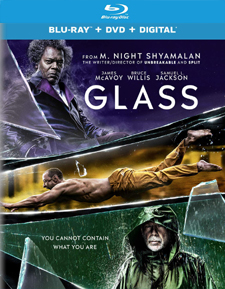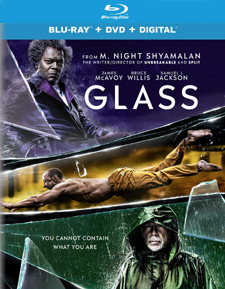Glass (Blu-ray Review)

Director
M. Night ShyamalanRelease Date(s)
2019 (April 16, 2019)Studio(s)
Blumhouse Productions/Universal Pictures (Universal Pictures Home Entertainment)- Film/Program Grade: B
- Video Grade: A
- Audio Grade: A-
- Extras Grade: A
Review
Glass, directed by M. Night Shyamalan, combines characters from two of the director’s earlier films – Unbreakable and Split. The current film examines the mythology of comic books and superheroes without benefit of spandex tights or cape.
Reprising their roles from Unbreakable, Samuel L. Jackson is Elijah Price, aka “Mr. Glass” because of a condition that makes his bones extremely brittle, and Bruce Willis is David Dunn, who had survived a horrific train crash. They are joined by Kevin Wendell Crumb (James McAvoy) from Split, a man of multiple personalities including nine-year-old Hedwig, demure Patricia, and the frightening Beast, who can bend iron and feast on human flesh.
All have been committed to a high-security psychiatric facility outside Philadelphia, where Dr. Ellie Staple (Sarah Paulson) hopes to gain insight into what she believes are their delusions. Through a series of interviews, she tries to unlock the mystery of what makes these three unusual subjects tick and break the spell that compels their behavior.
When we first see him, Elijah is wheelchair-bound, his head cocked to the side. Every now and then, a facial tic causes his eye to flutter. He seems either over-medicated or brain dead. Later, Elijah takes on a more prominent role, attempting to engineer an escape from the facility.
Crumb’s room is surrounded by strobe lights that automatically flash to cause a personality shift when he becomes violent. One of the film’s most interesting aspects is watching McAvoy effortlessly slip from one alter-ego to another.
Dunn, arrested as a vigilante because of his pattern of leaving criminals and victims injured, finds himself in the company of Elijah, his adversary from Unbreakable, and Crumb. Dunn’s son Joseph (Spencer Treat Clark) tries to convince Dr. Staple that his father is not crazy, to no avail.
Shyamalan creates tension and elicits excellent performances from the three stars, especially McAvoy, who clearly dominates Glass. Known for twist endings in his earlier films (The Sixth Sense, The Village), he tries to bring the same element of surprise to Glass, only this time the big reveal comes off more as a shrug than a jaw dropper.
There’s far more dialogue in Glass than in a standard costume superhero film because it is concerned more with what’s in the heads of these men who believe they have powers beyond the norm. There are no CGI sequences of buildings being lifted, bridges being turned around, or knock-down, drag-out fights.
As she attempts to understand her patients’ personalities, Dr. Staple, a specialist in treating those afflicted by delusions of grandeur, contends that their abilities and weaknesses are all in their minds and can be explained by science and childhood traumas. During a group therapy session with Elijah, Dunn, and Crumb, she causes them to doubt themselves by presenting evidence that their disorders can be deconstructed to reveal root causes.
Rated PG-13, Glass is an awkward blend of characters from two prior films. The script often appears forced, undermining the director’s uncanny ability to create suspense and anticipation. The character of Kevin Wendell Crumb and McAvoy’s performance dominate, with Jackson and Willis more like supporting characters than leads. Definitely a quirky film, Glass combines horror, psychological thriller, and melodrama.
The Blu-ray, featuring 1080p high definition, has an aspect ratio of 2.35:1. Picture quality is excellent, with details such as the veins in the Beast’s body, facial stubble, and clothing, appearing clear and well-defined. The color palette is significant. Muted and dark colors dominate early scenes, with more vivid hues emerging as the story unfolds. A large pink room in which the three central characters are interviewed contrasts sharply with the grey, dimly lit hallways and other rooms of the institution. Certain colors are associated with specific characters – purple for Elijah (his outfit), and yellow for the Beast (his pants).
Audio is English Dolby Atmos. Dialogue is clear throughout. Ambient sounds are mixed so that they create atmosphere but do not distract. The sound is especially effective in the institution, with its echoes, mysterious off-camera noises, and footsteps enhancing the eeriness of the hospital. Fight scene noises are sweetened to make them more dramatic, such as when the Beast smashes a cop’s head against a van, bodies are thrown into objects, and a vehicle is overturned. Spanish and French language tracks are available in Dolby Digital 5.1, as are optional English, Spanish, and French subtitles.
Bonus features on the 2-Disc Blu-ray/DVD Combo Pack include an alternate opening, deleted scenes, and 12 brief behind-the-scenes featurettes. A Digital Copy code on a paper insert is also included.
Alternate Opening – Introduced by director M. Night Shyamalan, this opening is from an original concept. A montage of shots shows the interior of the mental institution that figures so prominently in the film. Shyamalan says this opening was dropped because the movie had “too many beginnings.”
Deleted Scenes – All 12 of the following scenes are introduced by Shyamalan, who comments on why they were eliminated.
1. David Alone at Bar
2. Patricia Talks to Cheerleaders
3. David Encounters Pierce
4. Casey in Art Class
5. Dr. Staple Explains Machine
6. Mrs. Price in Waiting Room
7. Mrs. Price Talks to Elijah
8. Dr. Staple Drinks Tea
9. Pierce Checks Elijah’s Room
10. Mrs. Price Tells Elijah About Surgery
11. David Submits to Dr. Staple
12. Patients Worship the Beast
The Collection of Main Characters – This is an overview and discussion by director Shyamalan and cast members of the attributes and personalities of the movie’s main characters.
1. David Dunn
2. Elijah Price
3. Kevin Wendell Crumb
4. The Rest of the Family
A Conversation with James McAvoy and M. Night Shyamalan – The director and actor ask each other questions about the making of Glass. Shyamalan describes it as a mixture of the thriller and comic book genres, and proudly refers to the level of performances as “extraordinary.” The movie is a fresh take on superheroes. Made on a modest budget, “the crash and bang happen within the character’s emotional state.” McAvoy plays more personalities in Glass than he did in Split.
Bringing the Team Back Together – Casts and crews of Shyamalan’s films comprise a kind of family. Many crew members have worked for him on several pictures.
David Dunn vs. the Beast – Producer Jason Blum and stunt coordinator Manny Silverio discuss the Beast’s animalistic run, which was accomplished with cables supporting a stunt double. The climactic fight scene was carefully choreographed and cost 1/10 of what it would have cost any other comic book movie. Behind-the-scenes clips are shown of the filming of the fight scene.
Glass Decoded – Shyamalan discusses the color palette. It starts monochromatically and gradually introduces pops of primary comic-book colors. Specific colors are associated with the characters: green (life giving) for Dunn, purple (royalty) for Elijah, since he thinks of himself that way, and ochre (a color prominent in Buddhist and Hindu religions) for the Beast, representing the prophet.
Breaking Glass: The Stunts – This short featurette shows how a scene of the Beast breaking through a window and falling several stories to the hard ground was created with green screen and a stunt double.
Connecting the Glass Universe – Director Shyamalan explains the relationship among the three films in his trilogy – Unbreakable, Split, and Glass – noting that Glass works as a stand-alone film and isn’t derivative of the previous pictures. It was easy writing a “great psychological thriller” because he already knew the voices of the characters.
M. Night Shyamalan: Behind the Lens – The director’s planning is precise and methodical, with considerable forethought going into the shots, performances, and dialogue. Crew members comment that he is “striving for the best and open-minded.” He challenges himself and the crew. One crew member estimates there were probably 50 drafts of the script and 75 cuts of the movie. According to the director himself, “Making movies is a version of torture.”
The Sound of Glass – Composer West Dylan Thordson discusses working directly with the screenplay and putting together rough ideas prior to actual filming. His score relies on percussive sounds, small ensemble recordings, and “tiny microscopic sounds,” all blended together. He worked on the film for nine months. The score was recoded in the actual hospital where the movie takes place.
Enhancing the Spectacle – Because audiences have come to expect big, spectacular scenes, as in the Marvel movies, the film used a considerable amount of computer generated imagery (CGI). This made possible the Beast’s prominent veins, the throwing of a heavy table, and the impressive water tank bursting. Often, these images are created by editing together several different shots to make them appear as one.
Raven Hill Memorial – The hospital used in the movie is a defunct mental hospital in Allentown, Pennsylvania, described by Samuel L. Jackson as “sufficiently spooky and creepy.” Shyamalan was able to make some revisions in the script to take advantage of the hospital’s turn-of-the-century grandeur because the location was found early on.
Night Vision – The director points out that comics and movies have many similarities. Storyboards, which look like comic book panels, enable the director to visualize the movie in an early stage. Shyamalan is not a fan of improvisation, preferring to stick firmly to the script. Every aspect of the film is given solid preparation. The director’s final shots are compared with their storyboards to show how close they are.
– Dennis Seuling

